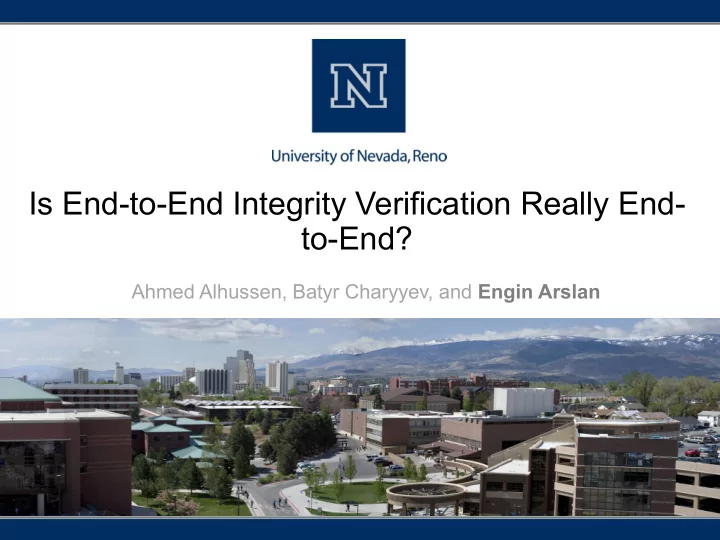

Is End-to-End Integrity Verification Really End- to-End? Ahmed Alhussen, Batyr Charyyev, and Engin Arslan
What’s End-to-End Integrity Verification Data corruption may occur during transfers – Faulty equipment, transient errors etc. Existing integrity check mechanisms are weak – TCP checksum fails to once in every 16 million to 10 billion packets End-to-end integrity verification offers strong fault- tolerance guarantee – Secure hash algorithms SHA1, SHA-254 – Captures errors that could happen anywhere during transfers; network, server, and disk (?)
How End-to-End Integrity Verification Works? Sender Receiver Read the file and send Receive the file and save
How End-to-End Integrity Verification Works? Sender Receiver Read the file and send Receive the file and save Read the file again and compute Read file back from storage and checksum compute checksum
How End-to-End Integrity Verification Works? Sender Receiver Read the file and send Receive the file and save Read the file again and compute Read file back from storage and checksum compute checksum Accept receiver’s checksum Send checksum
How End-to-End Integrity Verification Works? Sender Receiver Read the file and send Receive the file and save Read the file again and compute Read file back from storage and checksum compute checksum Accept receiver’s checksum Send checksum If checksums match Done
How End-to-End Integrity Verification Works? Sender Receiver Read the file and send Receive the file and save Read the file again and compute Read file back from storage and checksum compute checksum Accept receiver’s checksum Send checksum If checksums match Done Else Transfer again
Are Disk Write Errors Captured? 100% cache hit! Potential weakness to detect disk write errors!
Testing Integrity Verification Against Faults Four files 1-5 GB and one file 24 GB. Memory size is 20 GB One fault injected for each file during disk write Traditional approach failed to catch 4 out of 5 faults!
Proposed Solution Secure Integrity Verification Algorithm (SIVA) – Delay checksum computation to let kernel remove files from cache – Ensures that files are read from disk
Proposed Solution Secure Integrity Verification Algorithm (SIVA) – Delay checksum computation to let kernel remove files from cache – Ensures that files are read from disk
Future Work SIVA leads to ~4% cache hits. Can we reduce it even lower to avoid missing any disk corruptions? Delaying checksum incurs execution time overhead in return of stronger fault tolerance. How to optimize execution time without sacrificing accuracy? Explore ways to detect file cache removal to start checksum earlier
Questions?
Recommend
More recommend